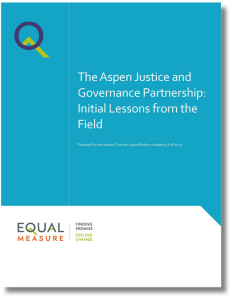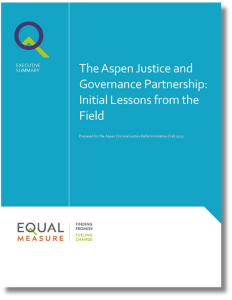“We recognize that there is systemic oppression in every system, and we see policy as being one of the greatest ways to change the oppressive system that we operate in.” —Planning Group Member
The Justice and Governance Partnership (JGP), the signature program of the Aspen Institute Criminal Justice Reform Initiative, is an ambitious initiative that aims to transform community safety and promote justice reform at the hyperlocal level.
Operating in mid-size cities and micropolitan and rural regions, the initiative emphasizes that neighborhoods with high crime rates and law enforcement engagement also face persistent insecurity in housing, health, education, transportation, and employment. JGP seeks to shift local justice ecosystems toward more fairness and equity through shared data and analysis that supports localities’ collaborative policymaking, partnerships, and resource sharing across law enforcement, government partners, and community members.
Grand Rapids, MI, became the first city to launch its own JGP initiative, the Grand Rapids Justice and Governance Partnership (GR-JGP). GR-JGP recently completed its first pilot year with Equal Measure as the national initiative’s learning and evaluation partner.
The lessons we learned from observing the implementation of a complex, deeply place-based, justice reform effort in Grand Rapids are relevant to funders and local leaders interested in high-quality design of place-based initiatives, justice reform, and centering racial equity and community decision making to achieve sustainable community change. The lessons learned included:
A trusted and adaptive host organization is necessary to support the complexity of hyperlocal, collaborative, criminal justice reform initiatives. In Grand Rapids, West Michigan Center for Arts + Technology (WMCAT), the host organization for the pilot year, is a trusted actor in the community and exhibited the flexibility and openness to change needed to build buy-in and momentum for the initiative. It was responsive to emerging needs and refined the collaborative’s initial recruitment and outreach strategy, helping to ensure the right people and institutions were at the table to anchor the work authentically and sustainably in the community for the long term.
Clearly and collaboratively defining “community” and naming race is essential to building trust and an understanding of shared purpose; the power dynamic between institutions and community members is not binary or unidirectional, but multidimensional and multidirectional. Explicitly defining who the initiative is for and how it will benefit them is a crucial component of this work. In Grand Rapids, explicitly naming the intended audience—Black residents and other residents of color in specific zip codes—helped build trust and shared understanding among the collective.
Establishing and maintaining a healthy balance between “top-down” and “community-up” design requires close attention to power dynamics and context, and an embrace of continuous communication. A core goal of the Justice and Governance Partnership is elevating community-driven solutions, which sometimes conflicted with expectations of efficiency and speed when attempting to contextualize and localize a complex and transformative initiative. Regular meetings between local initiative leads and Aspen technical assistance partners helped translate cross-sector and data-driven approaches as conceptualized by Aspen into activities that made sense in the local context.
The work of developing a representative coalition with a shared vision is dynamic, recursive, and time-intensive; it was a productive, forcing mechanism to promote common purpose and to uncover both challenges and opportunities. While Aspen’s technical assistance partners intended to create a local theory of change, its development also turned out to be useful in creating a shared vision of coordinated public safety resources and buy-in across the initiative—but took more time than originally planned or budgeted for. Time and capacity need to be built into complex community-based engagements to support this important but often under-resourced process.
To build momentum in hyperlocal criminal justice reform, deep, inclusive processes must be balanced with early collective discoveries and shared awareness of early successes. The Grand Rapids initiative leads determined it was necessary to shift strategies in the first year to include more stakeholders, which slowed the work and led to fluctuations in maintaining momentum. While a broadly inclusive process was necessary to authentically address deep-seated community issues and dynamics, it was balanced by a smaller leadership group that could make decisions and move nimbly.
We hope that sharing these lessons from Grand Rapid’s exciting first-year pilot of the Justice and Governance Partnership initiative can accelerate similar place-based, community-centered work. A full description of the initiative, its development, and the lessons learned in Grand Rapids can be found in the Lessons Learned Product and Executive Summary.

